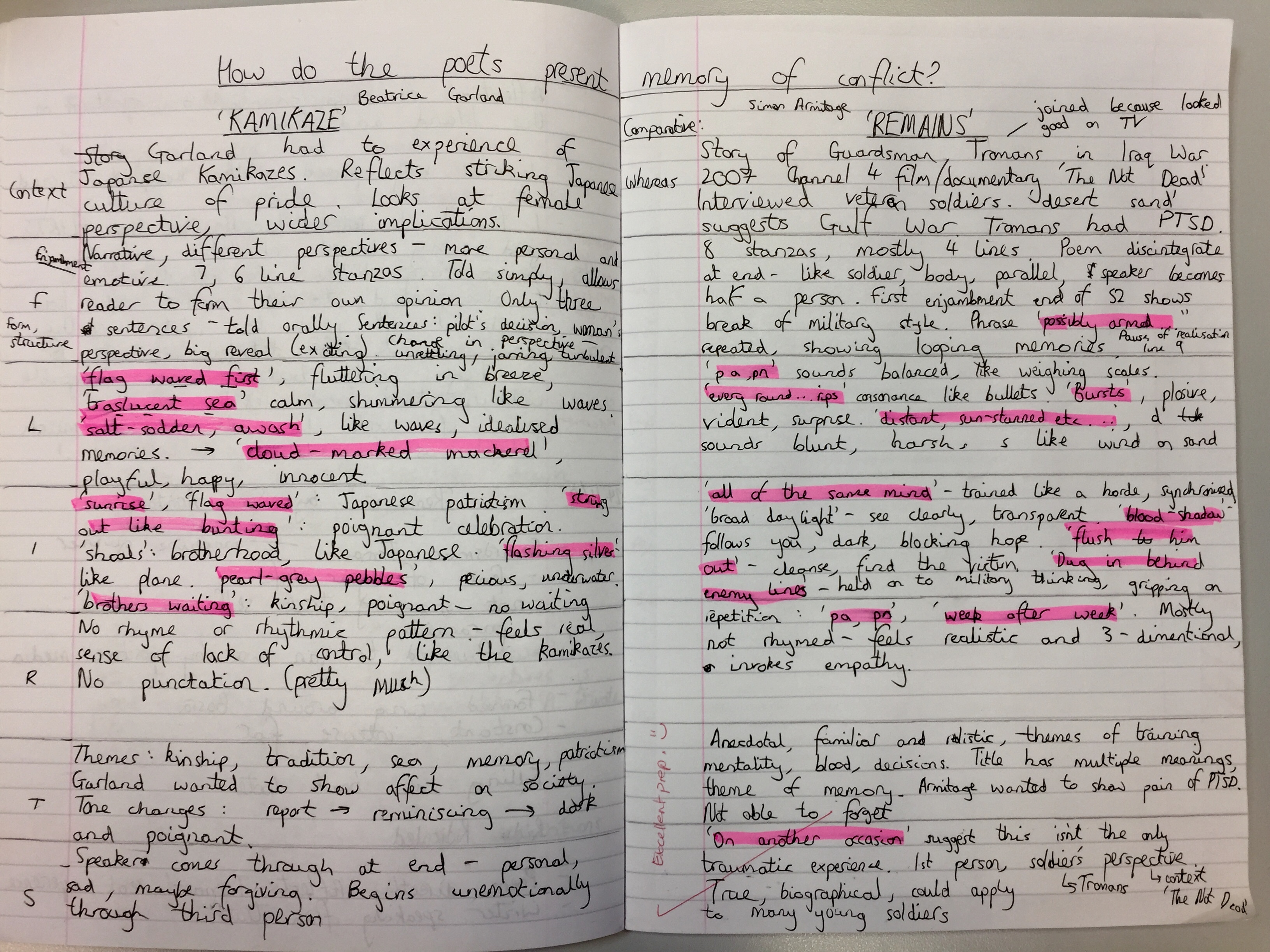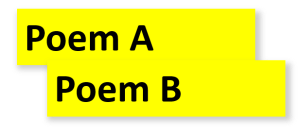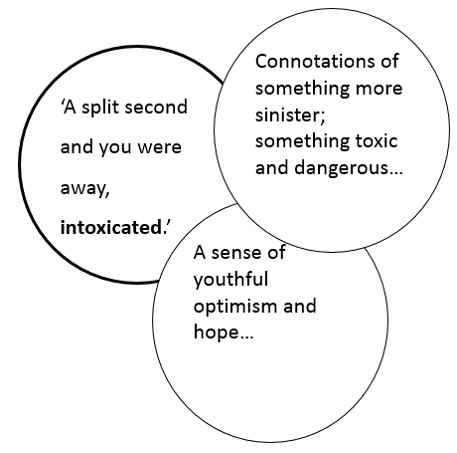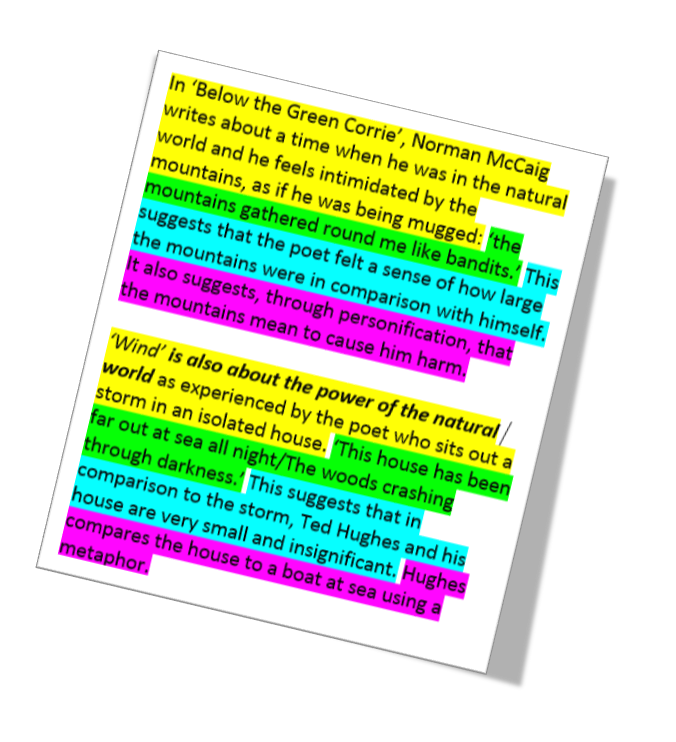

Comparing Texts

Question 7 of Section A of the exam requires you to compare Text One and Text Two. It is essential for the exam that you learn the techniques on how to compare texts.
This question is worth 15 marks and you will be solely assessed on AO3:
AO3 – Explore links and connections between writers’ ideas and perspectives, as well as how they are conveyed (makes up 15% of the overall exam).
Hopefully, your texts will already be annotated from the previous questions so it should not be too difficult for you to begin planning and then answering this question.
Again, it is vital that you plan out your essay in bullet points or by using a P E E table before you begin writing; this way you will not miss any important information and your essay will appear structured and focused, gaining you extra marks. However, the P E E table is slightly different with comparison questions:
Instead of having one example section you must include two. It is important in comparison questions that you complete an equal analysis of both texts and, because of this, it is not advised for you to use spider diagrams when planning a comparison essay.
Make sure you compare both the differences and the similarities of the two texts. You do not have to comment on every similarity and difference in the exam. However, it is important that you do not just comment on the content of the two texts. In the exam, you should comment on at least three of the following:
- Comparing the audience and form: do both texts have the same target audience? How do you know? Are both texts the same form? For example, are they both a magazine article? Or are they both a letter?
- The purpose of each text and how the writers achieve this.
- Comparing perspective: do the writers of both texts have the same or different perspectives? For example, both writers may be writing about the city of Paris. One of the writers enjoyed their experience of the city but the other did not. Here, you can compare their different perspectives or their similar perspectives.
- Comparing the use of structural techniques: paragraph lengths, sentence structures, sentence lengths, the overall shape of the text, repetition of words or phrases, rhyme schemes.
- Comparing characterisation and narrative voice: are the texts written in the same first/second/third person? Are the writers part of both texts? If so, are both narrators part of the text or are they characters in the story? Do the texts tell us anything about the personality of the writer?
- Comparing the use of language and literary devices: are similar language features or literary devices used to reinforce the writer’s ideas? For example, the use of alliteration, rhetorical questions, figures of speech (metaphors, personification, similes) etc.
- Comparing the subject, themes and ideas of the two texts: do they contain different themes or the same themes? Do they use different techniques to express their themes?
- Which text is more effective and why?
Make sure you spend no longer than five minutes planning your answer to this question. Try and use words, phrases or short bullet points when planning you essays, not whole sentences. Make sure you include a topic sentence for every paragraph you write in an essay.
You should develop a structure that works for you when writing out your responses to the comparison question. You may find the following example useful.
How to Structure a Comparison Question:
- Introduction: introduce both texts and state your point, giving a brief answer to the question. The rest of your essay should expand on what is written in your introduction.
- Similarities: bullet point the similarities of the two texts (is the purpose, audience, form, tone, language etc. similar?). You are advised to mention at least two similarities between the two texts.
- Differences: bullet point the differences of the two texts (is the purpose, audience, form, tone and language etc. different? And if so, are they aimed at different audiences?). You are advised to mention at least two differences between the two texts.
- Conclusion: which text do you believe is more effective and why? Make sure you relate back to the question in the conclusion.
The two texts may not have two similarities and so mention one similarity and three differences instead and vice versa.
Use connectives to connect the paragraphs of your essay. Connectives refer to using conjunctions at the beginning of every new paragraph or point, or to explain a point in more detail. We will split them up into ‘for’ and ‘against’ connectives:
It is vital that your comparison flows fluently and has a concise structure. Using the connectives mentioned above can help you achieve this. For example, your first paragraph in the main body of your essay may involve talking about a similarity that the two texts have; if the second paragraph talks about a difference then you can begin it using: ‘However, the two texts present a difference through their use of …’. Take note that a comma is always placed after a connective. If you apply this technique appropriately in any of your essays in Section A, B, or especially if you decide to do the argumentative/discursive task in Section C of the exam, then this will impress the examiner and gain you extra marks.

Interested in an English GCSE?
We offer the Edexcel IGCSE in English Language through our online campus.
Learn more about our english GCSE courses
Read another one of our posts
Understanding dementia: types, symptoms, and care needs.

A Comprehensive Guide to Health and Social Care Training

Understanding and Supporting Mental Health Conditions

The Role of Diet in Managing Chronic Diseases

Effective Communication Skills in Health and Social Care

Understanding Animal Training – Positive Reinforcement Techniques

Key Skills for Successful Care Home Management

Save your cart?
Comparing Poems
After studying this section you should be able to understand:
- what features to look for in each poem
- how to plan and write your response
As part of the GCSE English Literature course, one of the things you will need to do is to ‘explore relationships and comparisons between text, selecting and evaluating relevant material ’. One of the ways in which you might be asked to do this is to compare two poems.
When comparing poems you need to look for all the features that you look for when studying a single poem.
You need to look at the:
- content of the poem
- tone and mood of the poem
- form in which it is written and structured
- ways in which language is used
When writing your response, avoid writing an examination of one poem and then the other and comparing them in a final paragraph. Integrate your comments on the poems throughout.
However, you also need to compare these features in both poems.
You will need to look at each poem individually to plan your response, but when writing your response you need to integrate your ideas on both poems.
Watch the video below to help you understand key poetic terms and the forms and structure of poetry to help you analyse and compare poems for your unseen poetry paper.
Here’s one way you could approach this task:
Planning your response
1. Read both poems through carefully and get an overall sense of what each poem is about and how the poets handle their topics.
2. Re-read poem ‘A’ and make brief notes either around the poem, if you are able, or on a separate sheet, noting key words, phrases, images etc. and your response to it. Do the same with poem ‘B’.
3. Note down some brief quotations from each poem that you will use to illustrate your ideas. You could underline or circle these if you can write on the copy of the poem.
4. Make two lists – one headed similarities and one headed differences and list the main points under each heading.
Writing the response
It is important that you avoid writing an essay on each poem and then try to join them together. The best responses are those that integrate the ideas in parallel throughout the essay.
Here’s one way you could approach this:
INTRODUCTION
Introductory paragraph commenting on what each poem is about and capturing the ‘flavour’ of each.
Several paragraphs based on your detailed reading of the poems. It is a good idea to make a point about poem ‘A’ and then a point about poem ‘B’.
It can help you structure your ideas in a logical way, e.g. one paragraph could compare the way each uses imagery , while another paragraph could focus on structure etc.
A concluding paragraph, summing up the main similarities and differences, saying which you find more effective and why, if you are asked this .
Keep both poems at the centre of your focus and don’t be tempted to write all about one and then the other.

How to Compare Texts
Understanding the texts.
First, read the texts thoroughly . Understand the overall meaning and the smaller, nuanced details.
Identify the genre of the text. Knowing whether it’s fiction, non-fiction, poetry, etc, can help set a basis for comparison.
Pay attention to and analyse the language, style, and tone of the texts.
Contextual Understanding
Consider the historical and cultural context in which the texts are written. Contextual understanding can help explain the attitudes and values in the text.
Examine how the author’s background could have influenced their writing.
Comparing Themes and Ideas
Identify the main themes in each of the texts. These could include topics like love, death, freedom, etc.
Discuss how these themes are explored differently or similarly in the two texts.
Consider whether the texts share any common messages or values , or if they present conflicting ideas.
Comparing Characters
Identify the main characters in each text and compare their personalities, behaviours, and roles in the story.
Discuss how the authors have chosen to portray these characters- are they sympathetic, pitiful, admirable?
Comparing Narrative Techniques and Structure
Discuss the authors’ use of narrative techniques such as the point of view (first person, third person), use of dialogue, or use of imagery.
Compare the structure of the texts. Look out for things like the arrangement of ideas, use of paragraphs, and overall flow of the piece.
Writing the Comparison
Structure your ideas thoughtfully . One method is to discuss one text fully and then move onto the next. Another method is the alternate method, where you discuss one aspect of a text and then the corresponding aspect in the second text.
Use comparison linking words such as ‘similarly’, ‘on the other hand’, ‘whereas’, to clearly indicate when you are making comparisons.
Make sure your comparison is balanced . Devote equal attention to both texts in your analysis.
Include direct quotes from the texts to support your points.
Formulate a conclusion that summarises the similarities and differences between the texts.

Anthony Cockerill
| Writing | The written word | Teaching English |
Teach your students how to compare poems for GCSE English Literature, Paper 2, Section B
Learn some of these brilliant strategies for teaching really effective poetry comparison for GCSE English Literature, Paper 2, Section B.
One of the elements of our students’ exam performance we identified as a weakness in last summer’s examination series was comparing poems from the AQA poetry anthology, Poems Past and Present, which forms part of GCSE English Literature Paper Two. In the English Department at Boroughbridge High School, where we teach the Power and Conflict cluster, we’ve been spending time over these past few weeks taking a closer look at what our students need to do in order to write a great poetry comparison. Using our current students’ work alongside papers we recalled from last summer – plus the ever helpful examiner’s report – we’re working to establish some maxims for how we teach this particular aspect of the examination, which I’d like to share with you in this blog post.
1. Get your students to know the poems really well.
‘Students who knew the text were able to move around and within it in order to respond to the specifics of the task.’ AQA Examiners’ report, June 2017.
There are some great ways to introduce students to poems, such as D irected A ctivities R elated to T exts, in which a student is usually instructed to reconstruct or resequence a text. An activity might encourage students to think about the form of the text, the structure, or the recurrence of particular types of language.

As a first encounter with Seamus Heaney’s ‘Storm on the Island’, students might consider what the poem could be about by exploring the nouns. Are there any patterns? Could they be classified into lexical fields? Or they might attempt to write a poem or description using words sorted by their function. Alternatively, a teacher might encourage students to engage intellectually or emotionally with the poem by exploring a still image, a moving image clip or by sharing a story.
The subsequent process of the shared reading of the poem in its entirety and the ensuing discussion is a great opportunity to model the process of reading, understanding and thinking analytically. A series of prompts – or something akin to ‘Key Questions’ – can work as a framework for class discussion, enabling students to think, and ultimately write, about the poems and also to provide a ‘schema’ to help them build and consolidate their knowledge and understanding.

When helping students to deal with aspects of language and structure, a teacher might provide a tool to help students structure their thinking and note-making (the acronym FLIRTS, for example, which stands for F orm and Structure, L anguage and Sounds, I magery, R hyme, Rhythm and Repetition, T heme and Tone, S peaker).

2. Cluster and study the poems thematically to help students to make a good choice of second poem.
‘The selection of the second poem is one of the keys to success as this gives the student the material to construct a holistic response.’ AQA Examiners’ report, June 2017.
The Power and Conflict cluster could be usefully divided into poems about power and legacy; poems about the power of natural world and conflict with humans; poems about conflict that can happen as a result of culture and belonging; poems about war and conflict. Thinking about the poems in these clusters will guide students toward making a helpful choice of second poem.

3. Don’t constrict written responses with a rigid framework, but instead provide more flexible ways of comparing the poems.
‘One examiner commented that one of their key teaching points for next year will be that “comparison comes in a variety of shapes and does not have to be formulaic”‘. AQA Examiners’ report, June 2017.
Some of the possible ways of structuring a poetry comparison can lead to answers which can constrain the level of the response. This can usually be evident when ‘essay plans’ are too simplistic (Poem A, then Poem B) or too artificial (Similarities and Differences) but also when they become too unwieldy. But the examiners’ report suggests that ‘…the key message here is to enable and guide students to form a comparison relative to their level of ability.’ In engaging with the poems, a student aiming for a top grade should aim for a conceptualised response which is exploratory in nature. A confident student might write an ambitious introduction which outlines their ‘angle’ on the question. They might seek an interesting angle on the task, such as how patriotism might lead soldiers into combat. Then they might develop their response along a series of conceptual lines of enquiry, integrating analysis of the writers’ methods as they go; illuminating their interpretation with contextual insight relevant to the task.

Rather than offering up a rigid ‘essay plan’, the ‘series of prompts’ I described above as a cognitive tool can function, when applied to both poems, as a sort of ‘loose structure’ to help students produce a more focused written response. I have found these ‘Key Questions’ to be useful in encouraging students to focus on a comparison of two poems. ‘What are the poems about?’ serves as an introduction to the whole response.

‘Who is ‘speaking’ in the poems?’, as I discuss in more detail below, allows the student to engage with the ‘constructed voice’ of the poem. ‘How has the poet used language and structure to convey their message?’ allows students to consider the writers’ methods. ‘Why have the poems been written?’ offers the opportunity to explore deeper layers of meaning, authorial intent and conceptual interpretations. However, it’s important to think of this approach as flexibly as possible. It wouldn’t be good, for example, to encourage students to think of the Key Question ‘why have the poems been written?’ as an opportunity to shoehorn context into their response. Ideas, exploration of the writers’ methods and apt integration of context should be evident throughout the response.
4. Think about the voice as a construct.
‘Students who recognised where the voice was a construct were more successful than those who regurgitated biographical information about the poet that they then attempted to link to the poetic voice.’ AQA Examiners’ report, June 2017.
Addressing the task itself – and considering why the poems might have been written – will enable the student to naturally explore context – rather than including lots of biographical information. But the ‘persona’ of the constructed voice might also provide a very useful way of considering context. In Simon Armitage’s ‘Remains’, for example, the narrative voice deftly reflects the turmoil of someone struggling to come to terms with what they’ve seen. Armitage’s narrator uses first-person plural pronouns, for example, to emphasise the narrator’s attempt to redistribute his own guilt among his comrades. Similarly in ‘Beatrice Garland’s ‘Kamikaze’, the modulating narrative perspective creates distance between the reader and the narrator that reflect the gulf between pilot and family. Context in this analysis, therefore, becomes implicitly connected to the student’s understanding of the task.
5. Make sure students understand the importance of answering the question.
When students start to write their responses – and if they’re using my ‘Key Questions’ approach, they’ll begin by considering what the poems are about – they must respond in terms of the question rather than with something generic. ‘Ozymandias’ by Percy Bysshe Shelley for example, explores the power of the natural world, but if the question is about the theme of mortality, then it is through this filter that the student must construct their response. It’s useful reiterate the key word from the question throughout throughout the answer to keep the response on track.
6. Get students to engage with the poem, rather than obsessing about poetry terminology.
‘Some responses set out to identify poetic techniques and employ as much terminology as possible before engaging with the poems themselves.’ AQA Examiners’ report, June 2017.
Sometimes, a student who is too heavy handed with various poetry terms can find themselves attributing questionable effects to the features they’ve ‘spotted’. It’s much better to encourage students to consider different layers of meaning in language and to consider possible interpretations.

7. Flexible analytical writing is much more effective than the PEE paragraph.
‘The use of structures such as PEE / PEA and its variants worked in the sense that they allowed students working at the lower levels to access Level 3 in the mark scheme. However less rigid structures worked better for those working at higher levels.’ AQA Examiners’ report, June 2017.
As I have explained in an earlier blog post , I’m not sure I always taught analytical writing well earlier in my teaching career. For me, like many, the PEE paragraph was a formula to get students through coursework essays and to use as a model for exam-style responses.

8. Teach students to integrate and embed short quotations – it’s much more effective than copying out longer quotations.

It’s much more productive when students embed judiciously chosen, short quotations into the essay, rather than wasting time copying out large chunks of text. The response will feel much more fluid.
9. Encourage students to write individual responses with precise, cogent expression and more sophisticated analytical writing techniques.
When aiming for top flight responses, there are several techniques students can deploy as part of a well-structured, insightful essay. These include evaluation, anticipating the response of the reader, tentativity, spotting patterns and deepening analysis are some great ways of making analytical writing more ambitious.

Here, the student has spotted patterns of language throughout the poem.
The student here has noted the ambiguity of the poem in this example of deepening analysis…
10. Familiarise students with how their work will be marked.
‘Mark schemes’ should be used with care, as the process of arriving at a level is a subjective judgement based around a guided standardisation process. Futhermore, the meta-language around each level needs to be properly exemplified and understood – something even experienced teachers and examiners need ongoing support with. This said, it is always a worthwhile exercise to share with students an exemplar script or two and a ‘friendly’ version of the mark scheme they can use to become familiar with the standard and where their own writing sits.
Photo by Artur Matosyan on Unsplash
- Click to share on Twitter (Opens in new window)
- Click to share on Facebook (Opens in new window)
- Click to share on Pinterest (Opens in new window)
- Click to email a link to a friend (Opens in new window)

- Already have a WordPress.com account? Log in now.
- Subscribe Subscribed
- Copy shortlink
- Report this content
- View post in Reader
- Manage subscriptions
- Collapse this bar

How to get top marks in the AQA Power and Conflict Exam Question (by an AQA Examiner)
Below, you’ll find an answer on how to get top marks in the AQA Power and Conflict Exam Question. This question can be a bit tricky! The first thing to do is understand all the themes and ideas of each poem. Then, practise planning and writing until you feel like the essay’s easy to do! Plan at least five essays, and write at least three before you take the exam. Try to get feedback in between each essay that you write.
For the L7-L9 grades, examiners look for depth and complexity – I should know, I’m an AQA examiner and I must have marked hundreds of answers on this question in my time! Rather than being basic and just thinking about how the poem shows ‘power’ or ‘conflict’, try to go deeper and more precisely into your interpretations. You can use revision guides to help you understand how to do this; if you just react to the poems yourself then you’ll only have very basic ideas.
We made a full course on Power and Conflict poems, check it out here if you need help with them.
Each poem is broken down in great detail, including looking into context, meaning, attitudes, language techniques and speaker/voice. There are also video lessons on the poems, sample essay answers and tips for how to write perfect essays.
How to write the Power and Conflict Essay:
It’s a comparative essay that you have to write, with one given poem and one of your choice. The exam question looks like this:
Compare how poets present the effects of memory on people in Poppies and in one other poem from Power and Conflict.
Power and Conflict Poetry Anthology List – English Literature
You can see that it has a remind to ‘COMPARE’ – this means to write a comparative essay . The best structure to use is this:
- Intro – a sensitive, thoughtful point of comparison or contrast between the poems
- PARAGRAPH 1 – one topic to do with the question
- Poem A: Explore the topic
- Poem B: Explore and compare back to what you said about Poem A
- PARAGRAPH 2 – a different topic to do with the question
- PARAGRAPH 3 – a different topic to do with the question
- CONCLUSION – summarise your strongest ideas again
Thanks for reading! If you need more help with Power and Conflict poems, take a look at our full course .
Related Posts

The Theme of Morality in To Kill A Mockingbird

Unseen Poetry Exam Practice – Spring

To Kill A Mockingbird Essay Writing – PEE Breakdown

Unseen Poetry Exam Practice: The Man He Killed

An Inspector Calls – Official AQA Exam Questions

How to Get Started with Narrative Writing

What do I need to do for AQA Language Paper 2?

How to do well in the AQA GCSE Paper 2 Exam!

How to Write a Perfect Essay on The Crucible by Arthur Miller

AQA Power and Conflict: Example A* / L9 Grade Paragraph
© Copyright Scrbbly 2022

IMAGES
VIDEO
COMMENTS
How to end a poetry comparison essay. It is always a good idea to include a conclusion to your essay so that it reads coherently throughout. However, there is no need to spend a long time writing it. A conclusion for a poetry anthology comparison essay should only summarise the proof you have provided for your thesis.
When you compare texts, it's important to talk about both texts all the way through. Don't write all about one text, then all about the other. In each paragraph, make sure you mention both ...
Packing your analysis of two poems into one essay involves planning. There are different ways you could approach writing a comparative essay. These are some points to think about:
When you compare texts, it's important to talk about both texts all the way through. Don't write all about one text, then all about the other. In each paragraph, make sure you mention both ...
Topic Sentences: Start each paragraph with a clear topic sentence that states the aspect of comparison. Comparison: Analyse each poem separately, focusing on the chosen aspect (e.g., theme, structure). Then, compare and contrast the same aspect in both poems. Use of Evidence: Provide evidence from the poems to support your analysis (quotations).
It is vital that your comparison flows fluently and has a concise structure. Using the connectives mentioned above can help you achieve this. For example, your first paragraph in the main body of your essay may involve talking about a similarity that the two texts have; if the second paragraph talks about a difference then you can begin it using: 'However, the two texts present a difference ...
Watch the video below to help you understand key poetic terms and the forms and structure of poetry to help you analyse and compare poems for your unseen poetry paper. Here's one way you could approach this task: Planning your response. 1. Read both poems through carefully and get an overall sense of what each poem is about and how the poets ...
The second question you'll answer on English Literature Paper 2 will be the poetry comparison question based on the Love and Relationships section of the AQA anthology. You have 1 hour 45 minutes for his paper so you should spend around 45 minutes on this question. You will be given the text of one poem which you must write about in your ...
War Photographer: https://genius.com/Carol-ann-duffy-war-photographer-annotatedRemains:https://genius.com/Simon-armitage-remains-annotated Follow my Instagra...
Join my £10 Jekyll & Hyde Masterclass on 9 MAY HERE. Enter Your GCSE Exams Feeling CONFIDENT & READY! https://www.firstratetutors.com/gcse-classesSign up for...
Ms Turville Petre takes you through a method for writing a comparison essay for the anthology section of your literature GCSE
The key thing with comparison essays is to make sure that the essays do compare the two factors throughout. There are two ways to do this: 1) Compare them directly throughout the essay. For example, if you were comparing how Person A and Person B contributed to Medicine in the Renaissance, you could talk structure one point as follows -.
Main Body. There should be at least 3 paragraphs which make up the main body of your essay . You could... Examine relationships between characters (conflict between Mr Birling & the Inspector and class, Eva & Gerald's relationship and gender) Examine a specific character (Sheila and social mobility/gender, Eva the fallen woman/working class)
Both texts use similes close simile A comparison using 'like' or 'as' to create a vivid image, eg as big as a whale; float like a butterfly, sting like a bee. to make the accidents more vivid for ...
Writing the Comparison. Structure your ideas thoughtfully. One method is to discuss one text fully and then move onto the next. Another method is the alternate method, where you discuss one aspect of a text and then the corresponding aspect in the second text. Use comparison linking words such as 'similarly', 'on the other hand ...
For a coursework essay, you can take your time over this, and the same skills can be used to do the same thing efficiently in an exam. Step 1: READ!! Read the poems, and then read them again, and probably again just to be sure. Step 2: After reading through both poems thoroughly, you can make notes for each poem according to STRIP factors ...
Responding to poetry - AQA Essay plan. Responding to poetry - AQA. Writing your response to a poem, or making comparisons between two poems, takes careful planning. These tips show you how to ...
It's much more productive when students embed judiciously chosen, short quotations into the essay, rather than wasting time copying out large chunks of text. The response will feel much more fluid. 9. Encourage students to write individual responses with precise, cogent expression and more sophisticated analytical writing techniques.
How to write the Power and Conflict Essay: It's a comparative essay that you have to write, with one given poem and one of your choice. The exam question looks like this: Compare how poets present the effects of memory on people in Poppies and in one other poem from Power and Conflict. Power and Conflict Poetry Anthology List - English ...
Final Tips. In conclusion, writing a comparison essay involves selecting two or more subjects with significant similarities and differences, developing a strong thesis statement, and organizing your essay using either a point-by-point or block structure. By providing detailed analysis, addressing counterarguments, and using credible evidence ...
Comparing involves directly linking texts through their similarities and differences. It is important to move equally between the two texts, and write about them together, not separately. Part of ...